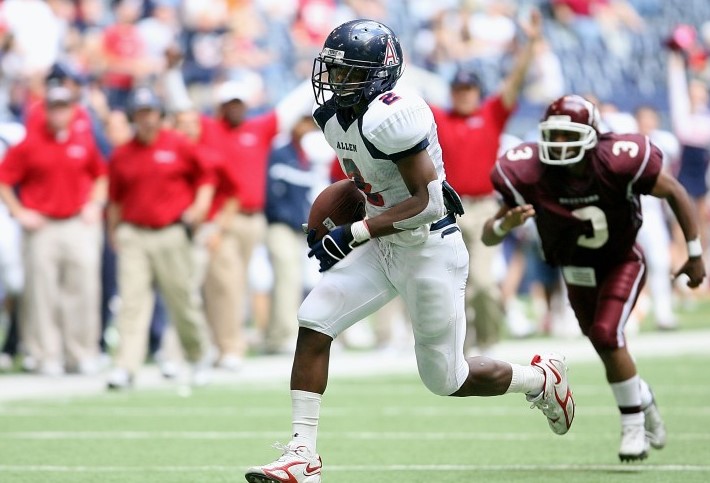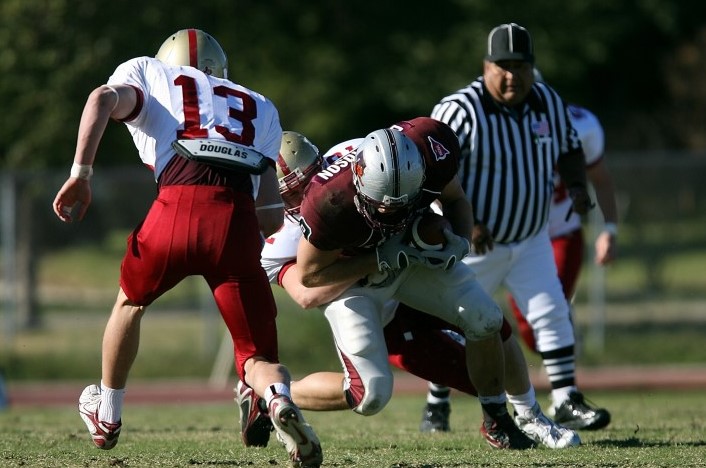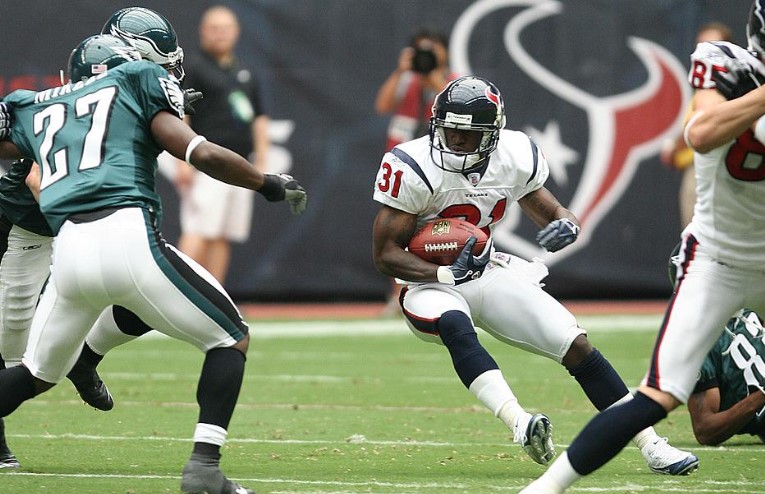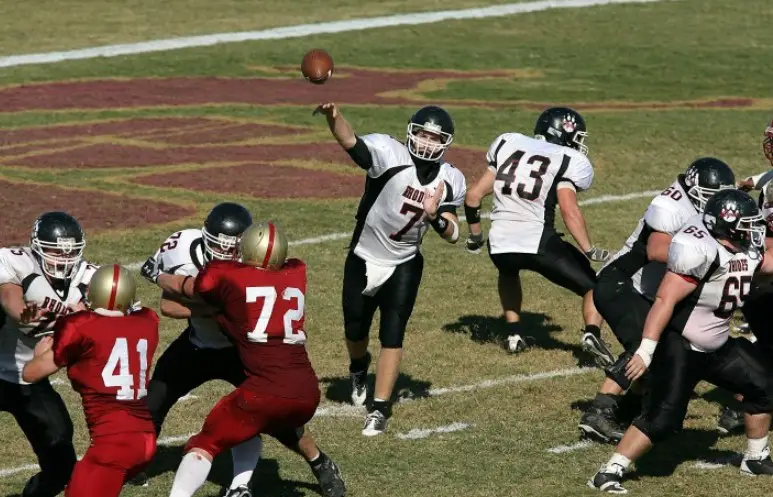Last Updated on October 2, 2023 by Alex PT
In American football, “running back” is a general term for players who carry the ball. “Halfback” and “tailback” are often used interchangeably, referring to fast runners. “Fullback” typically blocks and short-yardage runs.
Understanding the Difference Between a Running Back, Halfback, Tailback, and Full Back in American Football

Running Backs
A running back is the primary ball carrier on offense. He may line up anywhere from the quarterback to the wide receiver. A running back may also catch passes out of the backfield. The major responsibility of a running back is to run with the football and score touchdowns. They are typically the second-most crucial offensive players after the quarterback.
The position can be traced back to when football was first invented in 1892. In those days, players would take turns as both backs and linemen because they didn’t wear any protective equipment. They eventually realized it was more practical to wear pads and allow another player on their team to act as a runner while they lined up in formation during plays.
A running back is one of the prominent offensive positions in American football. He may also line up as part of a three- or four-man running back by committee (also known as RBC), where he is used more often to get first downs than touchdowns.
Many high school football teams use these players to prevent their opponent from scoring when winning big. The term running back has remained virtually unchanged since its introduction into the language in 1950.
Although some have been used slightly differently over time by different teams, several terms—fullback, tailback, slotback—have specific meanings within an offense that can differ from their standard definition.
Halfbacks

A halfback is an offensive back who lines up deepest in the backfield. A halfback typically runs plays from scrimmage more than any other offensive player except for the quarterback. He may also be used as a receiver on short passing plays. On running plays, he usually attempts to avoid tacklers by making quick cuts and jukes. When receivers are not open, he may act as a check-down option for his quarterback.
In short-yardage situations, such as third-and-one or fourth-and-one (a situation where one yard must be gained for a first down), some teams use their halfback as an extra blocker on either side of the ball. This makes it difficult for a defense to stop their play without endangering their runner. The term running back is usually applied to players at this position who can also carry the ball effectively.
Fullbacks

Fullbacks are also primarily ball carriers but are typically bigger than TBs. Fullbacks must be very powerful because they often serve as lead blockers for the TBs on runs from deep within the team’s territory. Halfbacks are another type of runner who can either be used as a third-down receiver or in certain formations as a pass-blocking defender against blitzing linebackers. The term halfback is also sometimes colloquially applied to both the RB and FB positions.
Tailbacks
A tailback (TB) is the primary ball carrier in an American football game. The term tailback originates from the old-school way of describing the position. The RB would line up behind the quarterback (QB), and the QB would hand him the ball off.
Today, however, most teams have replaced this system with a more modern one in which the RB lines up anywhere from directly behind the QB to several yards out wide. Their job is running with the ball and scoring touchdowns regardless of where they line up.
They are usually fast and agile but not as strong as other positions like linebackers or linemen. If you’re watching an NFL game and wondering what happened to all those big dudes on defense, you’re looking at them.
Difference Between a Running Back, Halfback, Tailback, and Full Back
| Position | Primary Responsibilities | Typical Skills Required |
|---|---|---|
| Running Back | A general term that involves carrying the ball during running plays. | Speed, agility, strength, and good hands for catching throws. |
| Halfback | Typically the main ball carrier is responsible for running with the ball, and they may also be involved in passing plays. | Speed, strength, high durability to withstand physical punishment and pass-catching skills. |
| Tailback | Generally, the last back in the formation is responsible for running with the ball from the backfield. They may also contribute to catching short passes from the backfield. | Speed and agility to find holes in the defense, agility for maneuvering past defenders, and steady hands for catching passes. |
| Fullback | Usually the lead blocker for the halfback or tailback during running plays. They are also occasionally used as short-yardage runners. | Strength and toughness for hard-hitting blocks, pass-catching skills, and moderate running abilities. |
The History of the Terms Halfback, Running Back, Half Bak, Tail Back, and Full Back
The term halfback was used to describe a player who lined up behind the quarterback in the early days of American football. The term running back came into use after developing the T-formation in the 1940s.
A tailback was originally a player lined up at the end of the line on offense and defense. The term fullback became popular after World War II when teams began using larger players in that position. Today, a fullback is often called an H-Back or TE (tight end).
The Roles of H-Backs (or Fullbacks) and Slot Backs (Tailbacks) in American Football
In American football, the halfback (HB) or fullback (FB) lines up in the backfield behind the quarterback. They are usually the largest and strongest players on the team, and their primary role is blocking for the quarterback and running backs. The fullback is also responsible for catching passes out of the backfield and can be used as a short-yardage runner.
The tailback (TB), also known as a slot back, lines up behind the fullback. Their primary role is to run the ball, but they are also involved in passing plays. They are usually smaller and faster than fullbacks and can be used as a receiver out of the backfield.
Characteristics of a running back, halfback, tailback, and full back
| Position | Characteristics |
|---|---|
| Running Back | Versatile player who carries the ball, catches passes, and blocks. Often the primary ball carrier. |
| Halfback | Quick and agile, known for speed and elusiveness. Used in various offensive plays, including running and receiving. |
| Tailback | Historically used in the backfield’s tail position. Similar to a halfback; quick, agile, and versatile. |
| Fullback | Typically larger and more physical than other backs. Primarily blocks for the ball carrier, used in short-yardage situations. |
Frequently Asked Questions
Are Full Backs Still Used in Today’s American Football?
The fullback position is the most misunderstood in all of football. Fans and even some coaches often confuse the roles of a fullback and a halfback. Football has four distinct types of backs: the running back, the halfback, the tailback, and the fullback.
What is the Role of a Full Back in American Football?
A fullback in American football is a member of the offensive backfield. Their basic role is to block for the running backs and protect the quarterback on passing plays. Fullbacks can occasionally run the ball and are often used as short-yardage runners.
Conclusion
The main difference between a running back, halfback, tailback, and fullback is the time they spend running with the ball. A running back tends to run more often than a halfback, who in turn runs more than a tailback. Fullbacks don’t run with the ball as often as the other three positions. However, all four positions may be used to run short distances with the ball to pick up first downs or score touchdowns.
Reference 1: Running Back Vs Halfback Vs Fullback – Metro League
Reference 2: Difference between Fullback, Halfback, and Running back in American football? – Best Sports Tutor

Hi! I’m Alex PT. I hold a Bachelor’s degree in Sports Management from Indiana University and have over seven years of valuable experience working in a Sports Event Management Company. I founded SportBlurb with the passion for bringing you the latest, most insightful, and engaging content in the world of sports. So, whether you’re a die-hard fan or want to stay informed, I’ve got you covered!

